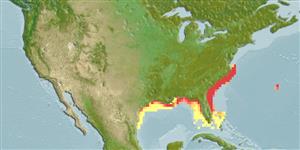Teleostei (teleosts) >
Pleuronectiformes (Flatfishes) >
Cyclopsettidae (Sand whiffs)
Etymology: Etropus: Greek, etron, -on = lower abdomen + Greek, pous = feet.
More on author: Gill.
Environment: milieu / climate zone / depth range / distribution range
Ecology
Marine; demersal; oceanodromous (Ref. 51243); depth range ? - 91 m (Ref. 5951). Subtropical; 37°N - 24°N
Western Atlantic: Canada (Ref. 5951) to North Carolina to Mississippi, USA, including the northern Gulf of Mexico.
Size / Weight / Age
Maturity: Lm ? range ? - ? cm
Max length : 13.0 cm TL male/unsexed; (Ref. 7251)
Life cycle and mating behavior
Maturities | Reproduction | Spawnings | Egg(s) | Fecundities | Larvae
Oviparous (Ref. 101737). Distinct pairing (Ref. 205). Females produce numerous eggs in multiple spawnings during a prolonged spawning period (Ref. 101737).
Leslie, A.J. Jr. and D.J. Stewart, 1986. Systematics and distributional ecology of Etropus (Pisces, Bothidae) on the Atlantic Coast of the United States with description of a new species. Copeia 1986(1):140-156. (Ref. 39355)
IUCN Red List Status (Ref. 130435)
Threat to humans
Harmless
Human uses
Tools
Special reports
Download XML
Internet sources
Estimates based on models
Preferred temperature (Ref.
123201): 22.8 - 26.1, mean 24.1 °C (based on 218 cells).
Phylogenetic diversity index (Ref.
82804): PD
50 = 0.5020 [Uniqueness, from 0.5 = low to 2.0 = high].
Bayesian length-weight: a=0.00871 (0.00387 - 0.01962), b=3.03 (2.83 - 3.23), in cm total length, based on LWR estimates for this (Sub)family-body shape (Ref.
93245).
Trophic level (Ref.
69278): 3.4 ±0.2 se; based on size and trophs of closest relatives
Resilience (Ref.
120179): High, minimum population doubling time less than 15 months (Preliminary K or Fecundity.).
Fishing Vulnerability (Ref.
59153): Low vulnerability (10 of 100).
